
10.15178/va.2019.148.77-99
RESEARCH
SOCIAL MEDIA MANAGEMENT IN LOCAL ADMINISTRATION: ANALYSIS OF RURAL MUNICIPALITES IN SPAIN
A GESTÃO DOS MEIOS SOCIAIS NA ADMINISTRAÇÃO LOCAL: ANALISSES DOS MUNICIPIOS RURAIS NA ESPANHA
LA GESTIÓN DE LOS MEDIOS SOCIALES EN LA ADMINISTRACIÓN LOCAL: ANÁLISIS DE LOS MUNICIPIOS RURALES ESPAÑOLES
Esmeralda López Alonso1
Doctora en Comunicación y Máster en Dirección y Administración de Empresas, es profesora del Departamento de Comunicación de la Universidad Europea de Madrid
Begoña Moreno López1
1University of Madrid. Spain
ABSTRACT
An increasingly global and technological communicative environment, with new media and support, and a much more dynamic behavior of citizens, has forced local authorities to have an active presence in social media. As a result of the theoretical review, we have detected that its management has been analyzed in some media. But only in the town halls of the provincial capitals and of the cities of more than 50,000 inhabitant not in the case of the smaller municipalities. Due to the importance of the rural environment in Spain, it is a must to investigate this draught. This work aims to know: the main social media that are being used in these municipalities; the person in charge of carrying out their management; and if they are implanted from a communicative strategy or not. The selected methodology has been the self-administered Internet survey for mayors and their communication departments. The results obtained see that the rural municipalities are making a great effort to join the Communication 2.0 and, more specifically, to adapt to the new social media environment. Although more and more municipalities take into account communication and understand it as a conversation with citizens, and not as mere unilateral information, there is still a long way to go.
KEY WORDS: local administration, social media, communication, strategy, management, stakeholders
RESUMEN
Un entorno comunicativo cada vez más global y tecnológico, con la aparición de nuevos medios y soportes, y un comportamiento mucho más dinámico de los ciudadanos, ha obligado a las administraciones locales a tener una presencia activa en los denominados medios sociales. Fruto de la revisión teórica hemos detectado que la gestión de éstos sí se ha analizado en los ayuntamientos de las capitales de provincia y ciudades de más de 50.000 habitantes, pero no en el caso de los municipios más pequeños. Dada la importancia del entorno rural en España, se hace necesario investigaciones de este calado. Este trabajo tiene por objetivo realizar una prospectiva de cómo es la gestión de los medios sociales en los ayuntamientos de los municipios rurales españoles. La metodología seleccionada ha sido la encuesta auto-administrada por Internet dirigida a alcaldes y a sus gabinetes de comunicación. Los resultados obtenidos vislumbran que los municipios rurales están haciendo un gran esfuerzo por sumarse a la comunicación 2.0 y, más concretamente, en adaptarse a estos medios sociales. Aunque cada vez son más los ayuntamientos que toman en cuenta la comunicación y la entienden como una conversación con los ciudadanos y no como mera información unilateral, queda mucho camino aún por recorrer.
PALABRAS CLAVE: Administración local, medios sociales, comunicación, estrategia, gestión, públicos de interés
RESUME
Um entorno comunicativo cada vez mais global e tecnológico, com a aparição de novos meios e suportes, e um comportamento muito mais dinâmico dos cidadãos, obrigaram à as administrações locais a ter uma presença ativa nos denominados meios sociais. Fruto da revisão teórica detectamos que a gestão destes efetivamente foram analisados pelas prefeituras das capitais de província e cidades com mais de cinquenta mil habitantes, mais não no caso dos municípios mais pequenos. Dada a importância do entorno rural na Espanha, se faz necessário investigações dessa importância. Este trabalho tem como objetivo realizar uma prospectiva de como e a gestão dos meios sociais nas prefeituras dos municípios rurais espanhóis. A metodologia selecionada foi a encosta auto administrada por internet dirigida a prefeitos e a os gabinetes de comunicação. Os resultados obtidos mostram que os municípios rurais estão fazendo um grande esforço por aderir-se à a comunicação 2.0 e, mais concretamente, adaptar-se a estes meios sócias. Embora cada vez são mais as prefeituras que levam em conta a comunicação e entendem como uma conversação com os cidadãos e não como mera informação unilateral, falta muito caminho por percorrer.
PALAVRAS CHAVE: Administração local, meios sociais, comunicação, estratégia, gestão, públicos
Correspondence: Esmeralda López Alonso. University of Madrid. Spain.
Esmeralda.lopez@universidadeuropea.es
Begoña Moreno López. University of Madrid. Spain.
Begona.moreno@universidadeuropea.es
Received: 25/02/2019
Accepted: 08/05/2019
Published: 15/09/2019
How to cite the article: López Alonso, E. and Moreno López, B. (2019). Social media management in local administration: Analysis of rural municipalities in Spain. [La gestión de los medios sociales en la Administración local: análisis de los municipios rurales españoles]. Vivat Academia. Revista de Comunicación, 148, 77-99.
DOI: http://doi.org/10.15178/va.2019.148.77-99
Recovered from http://www.vivatacademia.net/index.php/vivat/article/view/1163
1. INTRODUCTION
Although there is no consensus on the birth of social media, it is clear that since 2006 they have had an unimaginable growth, becoming the central core of the social web, a web that:
[…] democratizes the knowledge and participation of users in the environment; in which the co-creation of the contents generated in it is encouraged; and that allows the transfer of these contents between the different interactive digital media at the service of the user (Internet, mobile telephony, etc.)” (Martí, 2011, p. 206).
The terms social media, Web 2.0 and social networks are often used interchangeably, when they are different realities. For Kaplan and Haenlein (2010, p. 61) social media is “a group of Internet-based applications that are developed on the ideological and technological foundations of Web 2.0 and that allow the creation and exchange of user-generated content”. Concept that coincides with that of Constatinides (2014, p. 42), which defines them as “Web 2.0 applications that allow the creation, editing and dissemination of user-generated content.” Along the same lines, The white paper of IAB Spain: Communication in social media (1), points out that they are: “digital communication platforms that empower the user to generate content and share information through private or public profiles” (IAB Spain, 2009, p. 6).
(1) IAB Spain (2009). IAB white paper: Communication in social media. Retrieved from http://iabspain.es/categoria-de-estudio/tipo-de-documento/libro-blanco/
In the last decade, social media has become one of the most relevant tools for online collaboration, viral marketing, news updates and entertainment (Durango, 2015). Although many academics deal with the benefits and advantages of use, there are also negative currents around them such as Keen (2007) and Keegan (2007) that believe that they can have harmful consequences on culture, especially because of the ability to create content for users, without any informative rigor. In this sense, the misuse of new 2.0 technologies can make us more ignorant if we do not use a critical thinking when incorporating them in all areas (personal, educational and professional), since we are immersed in the process of defining the digital society of the 21st century (Celaya, 2011). On the other hand, Dans (2009) warns that, despite the high growth of social networks, its profitability and the development of use protocols are still in question.
Regarding their classification, it is a complicated task since they are constantly evolving and the appearance of new applications in the short term is very common. Constantinides and Fountain (2008) distinguish five categories: 1) blogs; 2) social networks; 3) forums and bulletin boards; 4) content communities; and 5) content aggregators. Another very complete classification is that proposed by Cobo and Pardo (2007), which consists of four categories:
It highlights one of the most comprehensive and most referenced classifications that of Kaplan and Haenlein (2010), based on theories of social media research and processes. They distinguish two dimensions: the social presence/wealth of the environment and self-presentation/self-dissemination. The social presence tries to explain the degree of contact that exists between two people during the communicative process; the wealth of the environment defines the amount of information that is transmitted over a period of time; the self-presentation determines the desire of the issuer to control the impressions that the rest has of him; and self- disclosure is the declaration of personal information, conscious or unconscious, depending on the image that is wanted to give. These authors classify them into six types: 1) collaborative projects; 2) blogs and microblogs; 3) content communities; 4) social networking sites; 5) virtual worlds; and 6) virtual games.
And finally, the definition of the IAB Spain (2009) is broader and includes blogs, photoblogs, microblogs, social and professional networks, graphic utilities, virtual worlds, dating, content aggregators, and in general, any application with which the user disseminates content that can be shared. This will be the classification that we take as a reference and starting point for our study, because still, being earlier in time and less referenced than that of Kaplan and Haenlein, it is more suited to the situation in which we are currently.
Currently, for example, there are no longer differences between many content communities and social networking sites, and in the latter, IAB studies (2018) also include instant messaging like WhatsApp, gradually tending to evolve towards the concept of digital social media. However, we have to keep in mind that “[…] while we are reading these words, most likely, on the other side of the world, someone will be devising a new platform that will leave obsolete in a few days to which we use today” (Cañabate, 2011, p. 12). We will address a description of the most relevant social media in the local administration. For this, an analysis table has been created that arises from the synthesis of the above-mentioned classifications.
Table 1. Classification of digital social media.

Source: Own elaboration.
1.1. Social media in town halls
The irruption of the Internet in Spain has caused changes at all levels of society, especially in the communicative context. The traditional communication model (2) from sender to receiver, based on unidirectional information that does not intentionally seek a response, has become obsolete. With the arrival of Web 2.0 organizations, public or private, no longer have control of the information flow. The symmetric two-way or double flow model (Gruning and Hunt, 1984) is the one that best reflects the changes that are taking place. Both the organization and the public can be persuaded to vary their behavior and the communicative initiative can be of both, with continuous feedback. Communication is transformed into a two-way model, focused on conversations, based on dialogue, transparency and collaboration.
(2) Also called press agent model or asymmetric information model.
The interaction provided by the social web enables collaboration between public administrations and citizens. These are no longer passive to become active agents or also called prosumer (3), which generate content, criticism and praise and share them in a digital community with similar tastes. They have become prescribers with a high power of influence, capable of favoring or damaging the image of an organization, causing a reputational crisis in the online world and that can easily expand in the offline world (Del Fresno, 2012). Faced with this change in citizen attitude, economic crises and corruption scandals, local governments in Spain have understood that it is necessary to make a change in communication if they want to generate a climate of trust with their public of interest.
(3) According to Islas-Carmona, “the word prosumer - in English, prosumer - is an acronym that comes from the merger of two words “producer” and “consumer”. The “prosumer” concept was anticipated by Marshall McLuhan and Barrington Nevitt who, in the book Take Today (1972), affirmed that electronic technology would allow the consumer to simultaneously assume the roles of producer and consumer of content”. (Islas-Carmona, 2008, p. 35).
The incorporation of town halls to social media has been progressively carried out. These have facilitated that the communication to be personalized and that there exists a continuous interaction between the administration and the citizens. The organizations that have understood the benefits of these new media have created real virtual communities where they involve the public, internal and external, both in new projects and their own identity, in order to provide value and differentiation.
The emergence of these social technologies as new channels has multiplied the multidirectional communicative opportunities, producing a fragmentation and segmentation of the contents, where it is possible to include images, voice, texts, infographics or videos in a universal space, which any user can access Easily from your mobile phone, tablet or computer. According to Jódar (2010), in this environment of technological innovation we face a generalized conversion of media, media and channels, implicitly leading to a change in mentality. One of the most immediate effects can be seen in the transmedia narrative, or also known as crossmedia, multimodality, multiplatform or enhanced narrative (enhaced storytelling).
According to this situation, we find a multitasking audience, capable of consuming different media at the same time, on different devices. Organizations have had to react, being present in these spaces so as not to lose the opportunity to communicate with their audiences, although not always with professionalism, since these technological supports require other operational skills and professionals adapted to the new scenario. In this sense, Campillo-Alhama and Martínez-Sala (2017) point out that it is essential to define a strategy in social media, with a guarantee of continuity and relevance of interaction, which establishes general and specific objectives.
In this system, the message becomes vitally important because the same content used on different platforms no longer serves. Now specific content with an individualistic approach is necessary. But, without forgetting that the messages are much more complex because they combine different formats: written, sound and visual.
As in any communicative relationship there is a variable that is noise. More and more users access the internet, thanks to its universality, and participate in the production of content, causing a huge amount of information. In many cases difficult to assimilate in such a short time, not because of the truthfulness of it but because of the abundance of data. This phenomenon is known as infoxication or information overload, a problem derived from technological progress that has an opposite effect, misinformation. “The challenge before was to generate adequate messages for the general public and get the attention of traditional media. Now the challenge is to make the institution visible among the large amount of information that is generated daily” (Romero & Mancinas, 2016, p. 132).
Never before has so much data been accessed, although the problem now lies in the difficulty of its management because of its storage, the cost involved, the analysis and visualization of that analysis so that it is understandable by those who make the decisions (Serrano, 2014). Therefore, it has been essential to create techniques and tools to try to manage that amount of references, quantitatively and qualitatively, that process the big data. Given the amount of interactions that are made in the field of social media, the study of the big data is very interesting for researchers and organizations. The use of this information gives entities a competitive advantage because of the value of the data that can be obtained to assess trends and make decisions.
Although the communicative model has been modified, with its advantages and disadvantages, we can say that the use of social media in the organizational environment is very timely. In addition to promoting intangibles, very specific niches in the market, very small groups of people, with more immediate and close communication are accessed (Lucas-Marín, 2013). Also, Jodar (2010) states that in this context, when multiplying the communication possibilities produced a content segmentation, which entails a more active user profile and new professional profiles. However, without forgetting the advantages of the social web, “it would be a mistake to miss any opportunity in the traditional communication actions to improve those relationships that we seek in the Network” (De-Aguilera, Farias & Baraybar, 2010, p. 110).
The social web has brought many communicative advantages for the administrations, but it has also caused some problems due to the speed in which the changes take place, leaving no time to assimilate the new knowledge, apart from the digital gap that it entails in municipalities with fewer resources. If we look at the study of Use and Attitudes of Digital Media Consumption (2017), we verify that for the smaller population size, the digital consumption (be it audiovisual, reading news, applications or photographs) is reduced. In the case of mobile applications there is a difference of 12 points with respect to larger populations and in the case of social networks the difference is reduced to only 6 points. Municipalities with less than 2,000 and those with 2001 to 10,000 inhabitants are the ones that use social networks to a lesser extent, with Facebook being the network most used by municipalities with less than 10,000 inhabitants.
In the last decade, studies on social media in the field of local administration are smaller than in business, highlighting (Criado, Pastor and Villodre, 2017 ACH Cambre, 2017; Criado, Rojas-Martin and Gil-Garcia, 2017; Criado, 2016; Criado, Rojas-Martin and Villodre, 2016; Aguilar, 2014; Palomar-Baget, 2013 and Ramos-Ostios, 2012). Most of these investigations focus only on the use of social networks and do not cover the entire national territory, they only study the municipalities of the provincial capitals or those of the municipalities with more than 50,000 inhabitants.
The conclusions that stand out from the latest published study by Criado, Pastor and Villodre (2017) on social networks in municipalities with more than 50,000 inhabitants are the following: 95.5% have institutional social networks, which are managed by a department of internal communication in 90% of the cases and only 34.4% have a strategic communication plan.
Given the importance of the rural environment in Spain, which occupies 85 percent of the territory and integrates 20 percent of the population (CES, 2018), we believe that this research is relevant.
2. OBJECTIVES
This research has as main objective to make a prospective of how is the management of social media in the municipalities of the Spanish rural municipalities in order to:
3. METHODOLOGY
Determining the universe of study has been a complicated task because different classifications of rural and urban municipalities have been found, with no single accepted definition (Goerlich-Gisbert & Cantarino-Martí, 2015). It has been followed the most used in the practice of official statistics that classifies as rural that municipality with a population below a certain threshold. For the National Institute of Statistics (INE), a rural municipality is when it has less than 10,000 inhabitants. Therefore, of the 8,124 municipalities in Spain according to the INE, 7,369 municipalities are rural (INE, 2018).
In a first phase, a literature review has been carried out to detect previous studies on the phenomenon analyzed, the conclusions obtained and the methodologies used, which have served as a guide for the selection of the research method. Thus, the type of research that has been carried out is non-experimental, descriptive in nature since the main objective is to give a general overview, approximate of this reality. Regarding the temporal scope, it is a sectional study since it is sought to analyze a particular moment, the current state.
Depending on the objectives and after the documentary analysis, we consider the quantitative method the most suitable, with the self-administered survey via the internet being the most pertinent technique for collecting the assessments of the subjects of study due to their speed and effectiveness.
To send the questionnaire, a database of the entire study universe, 7,369 municipalities of the rural municipalities, was made. This work was arduous, not only because of the number of local administrations but also because of the difficulties in finding corporate telephones and emails. Given the impossibility of contacting 98 municipalities, the questionnaire was sent to 7,271 mayors and communication offices, in Spanish as an official language and in Catalan, Basque and Galician in their respective territories, during the period from February to June 2018, with two reminders
968 valid questionnaires were collected on a population universe of 7,369 rural municipalities, representing a 99% confidence level and a margin of error of 3.86%.
4. RESULTS AND DISCUSSION
One of the main concerns of the present study was to find a representative sample, not only at a general level but rich in rural municipalities of different population sizes. This allowed us to collect much more accurate and detailed results and offer more accurate proposals.
We observe in Graph 1 that there is a varied index of responses regarding population size, highlighting the low participation of municipalities with less than 101 inhabitants. This may be due to different causes, among which we highlight the following: part of the sample whose town halls did not have a contact e-mail, nor their own telephone number, belonged to municipalities of this size; they are the ones that have the greatest problems for internet access; and those that have more complications of resource management, both economic and human, have.
Source: Own elaboration.
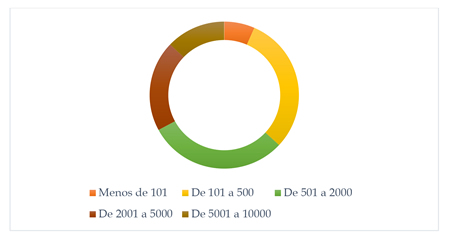
Graph 1. Response rate according to population size.
The analysis of the data is structured in three differentiated blocks whose sum offers a panoramic vision of the management of communication in social media of municipalities of less than 10,000 inhabitants.
4.1. Use of social media
It is observed that the main tools used for communication in municipalities with less than 10,000 inhabitants are, in this order: the bulletin board (84.19%); the website (76.85%); and social networks (in 71.17%).
Source: Own elaboration.
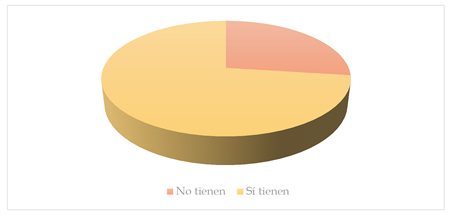
Graph 2. Employment of social networks.
This research focuses solely on analyzing communication with the public through social media, so municipal websites are considered only from this perspective. Of the total sample, only 53.71% carry out participatory actions on the corporate website. These are understood as simple surveys, citizen participation chats, the possibility of making comments and current forums. But only 31.40% can share content with other users and only 23.14% of rural web pages have a current blog.
From the point of view of social networks we observe that in 72.72% the municipalities that are part of the sample use institutional social networks. There is still 27.28% that do not.
With respect to the use of these social networks, most of the municipalities diversify the messages in several platforms. Facebook being the most outstanding, with a penetration rate of 93.04%. And below 50% are Twitter (44.68%), Instagram (24.82%) and YouTube (23.68%). These data are notably confronted with the study about the penetration of these social networks in municipalities with more than 50,000 inhabitants (Facebook 95.9%, Twitter 95.9% and YouTube 82.8% and Instagram that reaches only 56.6 %).
Source: Own elaboration.
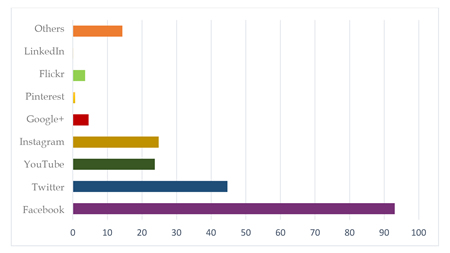
Graph 3. Most used social media.
It is worth noting that in the “Other” section, the municipalities participating in the sample highlight the applications (52.47%) on the one hand and WhatsApp groups on the other (38.61%) as the most used social networks. However, in the present investigation it does not deepen on the creation of WhatsApp groups by the municipalitie.
4.2. Professional profiles that manage social
Communication management, specifically on social media, is an item worth stopping to understand the panorama of rural municipalities in this matter. If we look at the data on the communication, the figure that holds this responsibility with great difference with respect to the rest is that of the mayor’s office (with 52.58%), followed by an internal communication cabinet or a communication manager ( 11’36%). Although there is a particularly relevant data at this point and it is the fact that in 9.6% of cases this responsibility is not held by Anyone, according to the sample result.
Source: Own elaboration.
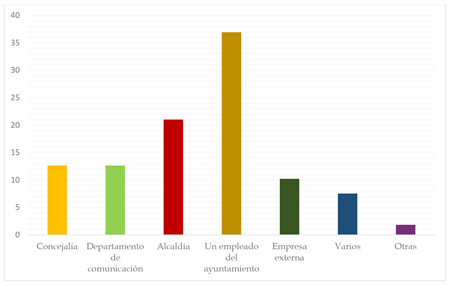
Graph 4. Responsible profile of social media.
With respect to the units involved in the management of social networks, responsibilities change (as we can see in Graph 4). Fundamentally, the weight of social media management rests with an employee of the city council in 38.44% of cases. The mayor being the next responsible for direct management in 17.93% of the time (understood as the sole figure of who holds the position and not as the cabinet or board of government).
It should be noted, although the percentage is very small, that in 1.97% of cases, or there is no one responsible for managing social networks (which results in its usefulness) or it is some volunteer neighbors who hold this responsibility. And although it may seem that this occurs in smaller municipalities, we have detected that this is not the case, finding representation of all population sizes.
This segmentation is complicated, in many cases, by a series of varied items that make communication difficult. Therefore, an approach is carried out to these inconveniences that these municipalities encounter when communicating with their public, especially in the use of social media (see Graph 5). It is observed that in 39.97% of the cases the lack of time is essential, followed closely by the lack of budgets (36.98%) and the lack of qualified personnel to implement it (29.33%).
There are two remarkable facts in this regard. On the one hand, 2.16% of the municipalities claim to have no difficulty. And on the other hand, 2.27% claim to have other difficulties such as poor internet connection (or lack thereof), a high percentage of older audiences who do not consume digital media and an excess of information that prevents audiences from discerning the relevant one of which it is not.
Source: Own elaboration.
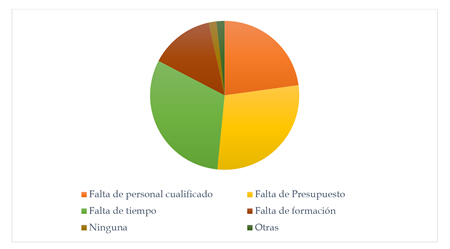
Graph 5. Difficulties in communicating with the public.
Municipalities that claim not to have difficulties in their communication are analyzed in depth and it is observed that they have population sizes of all the categories worked. So the hypothesis that this response is due to the fact that they are municipalities of less than 100 inhabitants with a great facility to access the public directly is refuted. In addition, it is detected that 9.52% of these municipalities do not have a website or use social networks and that 19.04% say they do not generate personalized messages.
4.3. Strategic social media communication plan
In the sample analyzed, we see that 66.63% of the municipalities with less than 10,000 inhabitants have no defined image that they want to project on public facilities (see Graph 6). And of those who do have it defined only 18.26% has it embodied in one strategic global plan of communication.
Source: Own elaboration.
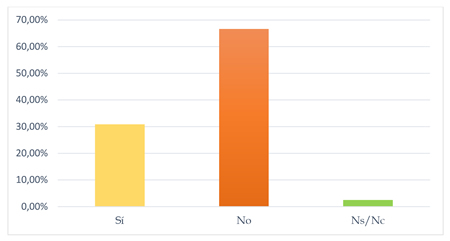
Graph 6. Definition of corporate identity.
The corporate visual identity manual, which includes all the elements that symbolically translate corporate identity, is absent in 72% of cases. And of that 28% that does have a manual only 31.73% includes the section on digital environment and social media in a differential way.
4.3.1. Segmentation by audiences
Although more than half claim to segment by audiences and use personalized messages for each of their audiences, there are still 43.59% of municipalities that do not develop this communicative strategy (see Graph 7).
Source: Own elaboration.
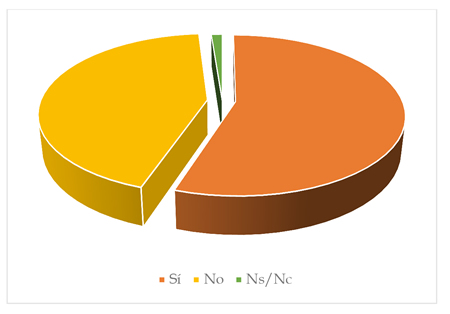
Graph 7. Segmentation by audiences.
In fact, taking into account the importance that municipalities of this population size give to communication with their audiences, we can see that only 35.64% consider as A lot, the relevance that this has for the municipality (see Graph 8), being Enough the majority response with 36.88% of choice.
It is highlighted that 8.25% do not know or give nothing or very little value to communication by audiences. And this corresponds in 91.66% to municipalities with less than 2,000 inhabitants.
Source: Own elaboration.
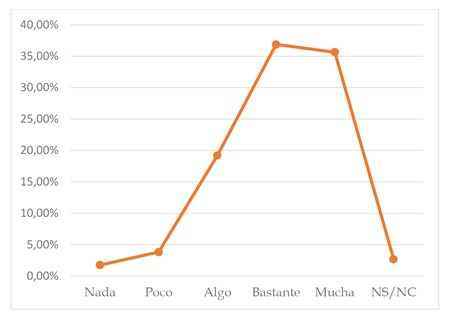
Graph 8. Importance of communication by audiences.
When analyzing the different audiences to which the municipal communication is directed, we observe that the main public of the rural municipalities corresponds in 96.9% to the neighbors in general (see Graph 9). The media and tourists are relegated to the second and third plane with 51.34% and 33.47%. Even when 55.16% of the municipalities affirm to segment by public, we see that this segmentation in all those internal publics of the municipality is still very scarce and communication is usually carried out at a general level.
Source: Own elaboration.
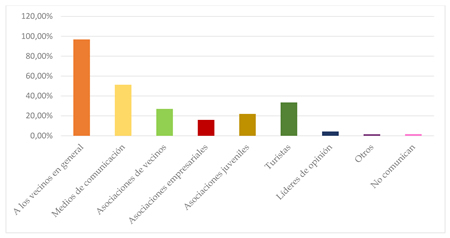
Graph 9. segmentation by audiences.
5. CONCLUSIONS
It is clear that rural municipalities are making a great effort to join communication 2.0 and, more specifically, to adapt to new social media. Although there are more and more municipalities that take communication into account and understand it as a conversation with citizens and not as mere unilateral information, there is still a long way to go. That the large municipalities, with more than 50,000 inhabitants, are already almost adapted to digitization seems a fact that is far from the reality of rural areas.
Smaller municipalities, especially those with less than 101 inhabitants, show that lack of digitization from the moment they do not have a website or public email operating on other online platforms (such as Provincial Councils, Federations of Municipalities, etc.). And this issue is increasing as the digital media that municipalities use in their communication are analyzed.
While it is true that this research focuses specifically on municipal communication through social media in order to propose an approximation to the panorama of our country, the main conclusion that can be extrapolated covers the entire communication environment. We can observe that the fundamental problem in rural municipalities lies in the basis of good identity management. In general, rural municipalities are not defining the image they want to project, nor establishing the common values and objectives that, as a municipality (and not as a political party) they want to convey. In addition, there are still a large number of municipalities that do not implement a defined and structured communication strategy around segmentation by audiences. Especially in municipalities with less than 2,000 inhabitants, there is a great lack of interest or value for segmentation by publics.
Going deeper into those municipalities that have defined their image and are working on segmentation strategies, we observe that there are few who implement the visual identity in a manual and grant a specific space to social media. What shows again that, despite the attempt to approach the large urban municipalities, the issue of communication in small municipalities is far from being the most optimal.
The consequences that communication policies may have regarding rural development and population fixing are a relevant point to consider. The fact that there is no defined segmentation by audiences means that audiences outside the municipality (such as tourists or media) do not receive the relevant personalized and strategically preconceived communication. Municipalities mainly focus on communicating with the neighbors they already have, but they do not plan to communicate with possible potential neighbors and attract population.
There are several difficulties and complications that municipalities of these characteristics face in order to proceed both to segmentation by publics and to the management of communication in social media. Taking them into account is key to being able to act pertinently on them and to alleviate the differences with urban municipalities. There are three fundamental points around which this problem is structured: lack of time, lack of budget and lack of qualified personnel. It is clear that, by solving the second, the remaining two can be minimized. In any case , it shows that it is not a lack of interest on the part of those responsible, but an enormous shortage of resources to cover all the obligations of a municipality.
It is encouraging that despite the difficulties social media occupies the second and third place of tools used in communication. What seems to predict growth and consolidation as conditions of social implementation of these digital media improve. While it is true that the conditions in which they are being implemented are far from relevant. The website as a communicative tool from the social point of view (which implies being able to generate and share content with users) is underused. In many cases, in addition, the content of the municipal blog is generated from the Provincial Councils and is replicated in all the municipalities of the province in the same way. And social networks are mostly reduced to Facebook. The fact that this is the social network par excellence in municipal communication of less than 10,000 inhabitants deserves an in-depth investigation about its user profiles in rural areas in order to consider which networks are more relevant, the type of communication and audiences that can be accessed through them.
Finally, by analyzing the management of the communication and observing the figures responsible for them, we can see that in the rural municipalities the figure of the mayor has the responsibility of directing, coordinating and in many cases managing the municipal communication. In many cases, this obligation falls on a municipal employee who does not have to be an expert in communication and responsible for this department. However, there is a long and hard way to go towards optimizing the management of social media by the municipalities of rural municipalities in Spain. In this situation it seems appropriate and advisable that mayors and government teams have the advice of external companies specialized in the management of communication with the public in social media or in those municipalities that have more resources, qualified professionals are hired to address these tasks.
Based on the conclusions obtained, in relation to the starting assumptions we could affirm the following:
The management of social media in the local administration is in an embryonic state, wasting the possibilities offered by these media for not having qualified professionals or developing communication strategies.
The mayors and their communication cabinets use social media to communicate with their neighbors but do not contemplate communication with other publics of interest.
6. RECOMENDATIONS
From the previous paragraphs you can glimpse the multitude of limitations that we have encountered in conducting this study. Fundamentally it is structured around the complexity of accessing information data directly. The contacts of those responsible of the municipalities, in this type of municipality, are not always provided on digital platforms. Access by telephone has also been complicated, especially in those municipalities that share secretaries and only have one day a week, at certain times to answer calls. In addition, it should be added that the universe of study is quite complex and requires a huge effort to obtain a representative sample. On the other hand, also highlight the difficult classification of social media in such a changing digital environment.
There are several future studies that may be undertaken, according to what is observed in this article:
REFERENCES
1. ACH Cambre (2017). Ayuntamientos, alcaldes y redes sociales. Recuperado de https://bit.ly/2tN1T6k
2. Aguilar J (2014). Estudio del uso de Twitter e Influencia de los Ayuntamientos españoles. Servicios Profesionales 2.0. Recuperado de https://bit.ly/2Rlsw2Q
3. Campillo-Alhama C, Martínez-Sala AM (2017). “Integrated communication 2.0 in municipal administration”. El profesional de la información 26(3), 507-515.
4. Cañabate JP (2011). Introducción a la comunicación institucional a través de Internet. Madrid: Grupo 5.
5. Celaya J (2011). La empresa en la web 2.0. El impacto de las redes sociales y las nuevas formas de comunicación online en la estrategia empresarial. Barcelona, España: Gestión 2000.
6. Cobo C, Pardo H (2007). Planeta Web 2.0. Inteligencia colectiva o medios fast food. Barcelona/México DF: Grup de Recerca d’Interaccions Digitals, Universitat de Vic.
7. Constantinides E, Fountain SJ (2008). Web 2.0: Conceptual foundations and marketing issues. Journal of Direct, Data, and Digital Marketing Practice 9(3):231-244. Recuperado de https://bit.ly/2Rjbsdy
8. Criado JI (2016). “Gobernanza inteligente, innovación abierta y tecnologías sociales en unas administraciones públicas colaborativas. ¿Hacia un cambio de paradigma?” En Criado JI (Ed.) (2016). Nuevas tendencias en la gestión pública (pp.22-48). Madrid: Instituto Nacional de Administración Pública.
9. Criado JI, Pastor V, Villodre J (2017). Redes sociales digitales en los ayuntamientos españoles. Colección NovaGob Academia, 2. Recuperado de https://novagob.org/documentos/redes-sociales-digitales-en-los-ayuntamientos-espanoles
10. Criado JI, Rojas-Martín F, Gil-García JR (2017). Enacting social media success in local public administrations: An empirical analysis of organizational, institutional, and contextual factors. International Journal of Public Sector Management 30(1):31-47.
11. Criado JI, Rojas-Martín F, Villodre J (2016). Open collaboration among practitioners and public management researchers in the social media era. The case of NovaGob. IRPM 20th Annual Conference, Hong Kong. Recuperado de https://bit.ly/2CWszJB
12. Dans E (2009). Prólogo. En J. Roca, Revolución LinkedIn: La red del profesional del management 2.0 del siglo XXI. (pp.11-16). Barcelona, España: Paidós Ibérica.
13. De-Aguilera M, Farias P, Baraybar A (2010). La comunicación universitaria: modelos, tendencias y herramientas para una nueva relación con sus públicos. Revista Icono 14, 8(2):90-124.
14. Del-Fresno M (2011). Cómo investigar la reputación online en los medios sociales de la web 2.0. Cuadernos de Comunicación Evoca 5(1):29-33.
15. Durango A (2015). Mercadotecnia en los medios sociales. Recuperado de https://bit.ly/2M3W27e
16. Goerlich-Gisbert FJ, Cantarino-Martí I (2015). Estimaciones de la población rural y urbana a nivel municipal. Estadística Española, 57(186):5-28.
17. Grunig JE, Hunt A (1984). Managing Public Relations. New York, Estados Unidos: Holt, Rinehart and Winston.
18. IAB Spain (2009). Libro blanco de IAB: La comunicación en medios sociales. Recuperado de https://bit.ly/2RltCvu
19. IAB Spain (2018). Estudio anual de redes sociales 2018. Recuperado de https://bit.ly/2J95UhE
20. INE (2018). Cifras oficiales de población de los municipios españoles: Revisión del padrón municipal. Recuperado de https://bit.ly/2QB2mE0
21. Islas-Carmona JO (2008). El prosumidor. El acto comunicativo de la sociedad de la ubicuidad. Palabra clave, 11(1):29-39. Recuperado de https://bit.ly/2I86qc9
22. Jódar JÁ (2010). La era digital: Nuevos medios, nuevos usuarios y nuevos profesionales. Razón y Palabra 15(71). Recuperado de https://bit.ly/2LLRyVV
23. Kaplan AM, Haenlein M (2010). Users of the world, unite! The challenges and opportunities of Social Media. Business Horizons, 53(1):9-68.
24. Keegan V (2007, 5 de julio). Amateurs can be good and bad news. Recuperado de https://bit.ly/2FjphBG
25. Keen A (2007). The Cult of the Amateur: How Today’s Internet is Killing our Culture. New York, United States: Doubleday.
26. Lucas-Marín A (Edit.) (2013). Sociología de las organizaciones. Influencia de las tecnologías de la información y de la comunicación. Madrid, España: Editorial Fragua.
27. Martí J (2011). Marketing y Publicidad en Internet. Madrid: Starbook.
28. ONTSI (Julio 2017). Estudio de uso y actitudes de consumo de los contenidos digitales. Recuperado de https://bit.ly/2xS9h2x
29. Palomar-Baget J (2013). “El uso de las redes sociales como herramientas formativas y comunicativas en la administración pública: estudio de caso de la EAPC”. En: Criado-Grande JI, Rojas-Martín F. Las redes sociales digitales en la gestión y las políticas públicas. Avances y desafíos para un gobierno abierto, (pp. 141-157). Generalitat de Catalunya: Escola d’Administració Pública de Catalunya.
30. Serrano J (2014). Big data y analítica web. Estudiar las corrientes y pescar en un océano de datos. El profesional de la información 23(6):561-565.
31. Romero LM, Mancinas R (2016). Comunicación institucional y cambio social. Claves para la comprensión de los factores relacionales de la comunicación estratégica y el nuevo ecosistema comunicacional. Sevilla, España: Ediciones Egregius.
32. Ramos-Ostio MJ (2012). Relaciones Públicas. 2.0: el uso de los medios sociales en la estrategia de comunicación online de marcas ciudad españolas. Revista Internacional de Relaciones Públicas 2(3):71-90.
AUTHORS
Esmeralda López Alonso: PhD in Communication and Master in Business Administration and Management, she is a professor in the Communication Department of the European University of Madrid. He teaches in the degrees of advertising, journalism and marketing and in the master of communication management. His main lines of research are related to the management of intangibles, municipal communication and social media. He combines teaching and consulting in marketing and communication.
Esmeralda.lopez@universidadeuropea.es
Orcid ID: https://orcid.org/0000-0003-4263-4581
Google Scholar:
https://scholar.google.es/citations?view_op=new_articles&hl=es&imq=Esmeralda+Lopez+Alonso
ResearcherID: V-2925-2018
IraLISID: ESCS3138
Exit ID: 4898
Begoña Moreno López: Doctor in Advertising and Master in Environment and Corporate Social Responsibility, she is a professor in the Communication Department of the European University of Madrid, in subjects related to creative thinking and corporate identity. His main lines of research are related to creativity, innovation and migrants. She has belonged as a researcher to the I.K. in the research project “Gender and Communication” and currently belongs to IN.MIGRA2-CM, and to the project “Communication and migration”.
Begona.moreno@universidadeuropea.es
Orcid ID: https://orcid.org/0000-0002-9035-7286
Google Scholar: https://scholar.google.com/citations?user=RV9WRi0AAAAJ
Exit ID: 4967